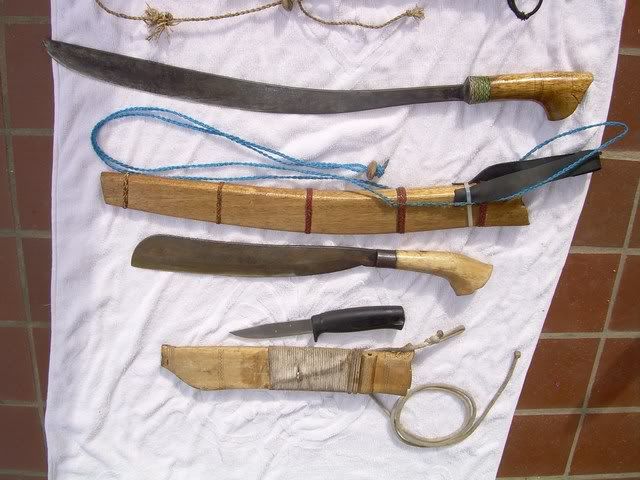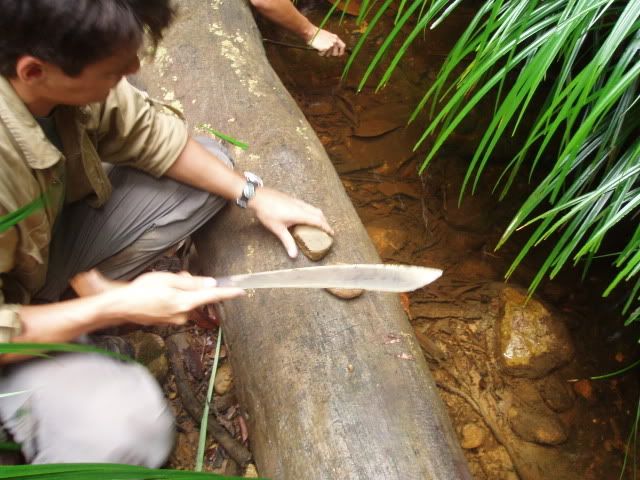Since parangs and machetes are often mentioned in this forum though usually commercially manufactured ones, I thought Id share with you the parangs that I use here in Borneo.
I made none of them and my contribution has been limited to cordage, zip ties and restraints for carrying the sheath which is why this thread is in Edged Tools not DIY.

The top one is a custom made heavy parang for heavy work and for dispatching boar; the idea being that the blade tip would enable a under body thrust to the chest or heart. The blade weight would also easily lop off a big boars head (not that I would ever get that close to one). The wood is sandalwood and has a very nice scent. Because of the weight I seldom bring it out for more than a short walk or when heavy duty chopping is needed. The steel is a Land Rover spring. It was made in the Temburong district of Brunei. It now has a couple of bad nicks in the edge the result of a recent spell of chopping while building a home for some BCUK people who may be coming out next year.
The second one (below the Opinel 8) is a Kayan pattern mandau but made by a Penan blacksmith in a Kenyah community (all these are interior tribes). The pattern is the traditional headhunters weapon though one expressly intended for that purpose would probably be a bit longer. The most distinctive feature is that the blade is convex on the right side and concave on the left. It is sharpened on one side only. It would be awkward for a left-hander to use but for a right-hander I think it would accentuate the right to left stroke and cut right-left.
It cuts and clears growth quite well but if you use it carelessly to blaze a tree on your right, it is likely to glance off and scare you as the blade comes towards your legs. If used on the left it will cut into the wood without taking out the bark and marking the blaze. I think, and am happy to be corrected, that the shape is meant to assist in cutting off heads cleanly much in the same way that an angled blow cuts across the woods grain more affectively than a strictly perpendicular one.
Another explanation is that it was traditionally used as a draw knife to work on the canoes. Perhaps any weapons experts here could let us know. I have seen a head severed very easily by the sister blade to this one even in the hands of a relatively inexperienced head-hunter (the victim was a pig!). If I had any scalps there would be a lock of the victims hair on the handle. This one just has some carvings done by another blacksmith who replaced the previous one. The sheath is a very lightweight wood like balsa and a smaller second knife is usually carried in an attached palm sheath but I do not carry it trusting the lighter work to a pocket folder. The little knife (3) originally was supposed to be used to trim off excess tissue from the severed heads and to detach the lower jaw which was not collected by the hunters. That may be so but nowadays it is used for less gruesome things.
The third one is a Baram Iban parang. As an EDC it is superb and is my usual first choice for comfort and if away for a few days. It is the lightest of them all but cuts and chops almost as well as the first two. Because it is lighter it is less work for trail cutting or clearing than the others. What is seldom, if ever, mentioned in the Parang vs. Axe discussions is that most of the cutting needed here is to cut small branches, tall grasses, ferns, vines, creepers etc. not 6 inch diameter saplings (these you walk around). In a sense it is like swordplay and a light blade is easier to manipulate and change direction. However, I have seen a 30m tree felled by one of these type of parangs in 10-12 minutes in the hands of an expert.

The fourth one (the sheepsfoot next to the Mora) is a Malay parang from Sabah. This is the standard work knife used by farmers and other rural workers. They use it for everything killing animals, chopping firewood, improvised structures and chasing away the daughters boyfriend. Very robust. I use it for batonning wood for the BBQ, digging mud out around tyres (if I forgot the changkol) and as well as cutting and clearing. It often stays in the 4x4. I carry it when I believe not much cutting is needed but just to be on the safe side or if I am in the company of people who are worried by bigger and more scarier looking knives such as when I am bringing some bird watchers on a nature walk. Non-local birdwatchers, I should say. It is no match or the others in the cutting and chopping stakes, however.
I would be happy to try and answer questions or hear from any parang enthusiasts here. These are very necessary tools over here that I have come to appreciate and admire.
I made none of them and my contribution has been limited to cordage, zip ties and restraints for carrying the sheath which is why this thread is in Edged Tools not DIY.

The top one is a custom made heavy parang for heavy work and for dispatching boar; the idea being that the blade tip would enable a under body thrust to the chest or heart. The blade weight would also easily lop off a big boars head (not that I would ever get that close to one). The wood is sandalwood and has a very nice scent. Because of the weight I seldom bring it out for more than a short walk or when heavy duty chopping is needed. The steel is a Land Rover spring. It was made in the Temburong district of Brunei. It now has a couple of bad nicks in the edge the result of a recent spell of chopping while building a home for some BCUK people who may be coming out next year.
The second one (below the Opinel 8) is a Kayan pattern mandau but made by a Penan blacksmith in a Kenyah community (all these are interior tribes). The pattern is the traditional headhunters weapon though one expressly intended for that purpose would probably be a bit longer. The most distinctive feature is that the blade is convex on the right side and concave on the left. It is sharpened on one side only. It would be awkward for a left-hander to use but for a right-hander I think it would accentuate the right to left stroke and cut right-left.
It cuts and clears growth quite well but if you use it carelessly to blaze a tree on your right, it is likely to glance off and scare you as the blade comes towards your legs. If used on the left it will cut into the wood without taking out the bark and marking the blaze. I think, and am happy to be corrected, that the shape is meant to assist in cutting off heads cleanly much in the same way that an angled blow cuts across the woods grain more affectively than a strictly perpendicular one.
Another explanation is that it was traditionally used as a draw knife to work on the canoes. Perhaps any weapons experts here could let us know. I have seen a head severed very easily by the sister blade to this one even in the hands of a relatively inexperienced head-hunter (the victim was a pig!). If I had any scalps there would be a lock of the victims hair on the handle. This one just has some carvings done by another blacksmith who replaced the previous one. The sheath is a very lightweight wood like balsa and a smaller second knife is usually carried in an attached palm sheath but I do not carry it trusting the lighter work to a pocket folder. The little knife (3) originally was supposed to be used to trim off excess tissue from the severed heads and to detach the lower jaw which was not collected by the hunters. That may be so but nowadays it is used for less gruesome things.
The third one is a Baram Iban parang. As an EDC it is superb and is my usual first choice for comfort and if away for a few days. It is the lightest of them all but cuts and chops almost as well as the first two. Because it is lighter it is less work for trail cutting or clearing than the others. What is seldom, if ever, mentioned in the Parang vs. Axe discussions is that most of the cutting needed here is to cut small branches, tall grasses, ferns, vines, creepers etc. not 6 inch diameter saplings (these you walk around). In a sense it is like swordplay and a light blade is easier to manipulate and change direction. However, I have seen a 30m tree felled by one of these type of parangs in 10-12 minutes in the hands of an expert.

The fourth one (the sheepsfoot next to the Mora) is a Malay parang from Sabah. This is the standard work knife used by farmers and other rural workers. They use it for everything killing animals, chopping firewood, improvised structures and chasing away the daughters boyfriend. Very robust. I use it for batonning wood for the BBQ, digging mud out around tyres (if I forgot the changkol) and as well as cutting and clearing. It often stays in the 4x4. I carry it when I believe not much cutting is needed but just to be on the safe side or if I am in the company of people who are worried by bigger and more scarier looking knives such as when I am bringing some bird watchers on a nature walk. Non-local birdwatchers, I should say. It is no match or the others in the cutting and chopping stakes, however.
I would be happy to try and answer questions or hear from any parang enthusiasts here. These are very necessary tools over here that I have come to appreciate and admire.

